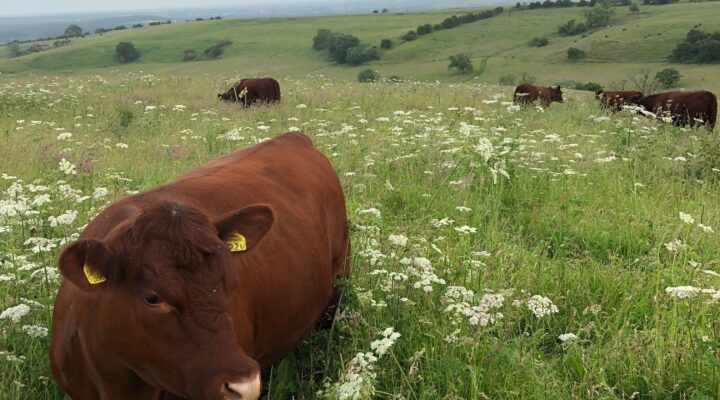Sarah’s first PfL farm walk
Sarah’s first PfL walk at Simon Herring’s farm in the Lincolnshire Wolds, on mob grazing Lincoln Red cattle and habitat creation.
 Lincoln Red cattle at Herring farm
Lincoln Red cattle at Herring farm
First PfL walk
Joining Pasture for Life (PfL) as the person responsible for delivering the Royal Countryside Fund (RCF) Farm for the Future (FftF) project in East Anglia and the East Midlands means my job title is just a few letters short of an acronym alphabet.
Put simply however, my role is to support the regional Pasture for Life facilitators to do what they do best: create strong, supportive and informative networking events for livestock farmers in their area.
This is already happening, as I have witnessed first hand, but with the PfL now the delivery partner for the RCF programme in many areas across the UK, this Defra-funded project has given extra fire-power to the people delivering for livestock farmers.
To immerse myself in the new role, I joined East Midland PfL facilitator Hannah Thorogood on a farm walk at Herring farm in Walesby, Lincolnshire.
The first thing to say is that, as someone who hails from neighbouring Norfolk, the hills came as a surprise. Say ‘Lincolnshire’ to any Norfolk resident and we instantly imagine fields of daffodils and tulips, rows of cabbages and cauliflowers and the flattest landscape imaginable. The Wolds are a rolling thing of beauty.
The next thing to strike me was the devotion among the group of 25 farmers to the local breed. Among the cohort of livestock owners on the farm walk, just about everyone I spoke to was breeding and rearing Lincoln Reds. The herd we met, spread across the farm, was a beautiful example of this native breed. Dazzlingly shiny coats, mellow behaviour, bright-eyed and inquisitive calves and a magnificent bull.
Talking to someone who also bred Lincoln Reds, his answer was to the question: ’Why Lincolns?’ was unequivocal: ‘They are brilliantly suited to the local environment, which means they can be out wintered and they do well on the grazing because it was what they were bred to eat.’
It was three years ago that Simon Herring and his family took over the farm and instantly committed to improving the soil health. Much of the land is now in various stewardship schemes and the results – in so short a time – are incredible. A field of blue chicory is sending nutrients deep into the soil; the planting of species rich leys provides a medicine cabinet of herbs for the grazing animals. Pasture massage with wild flower meadows hay means the diversity in the sward is being improved naturally by the cattle trampling, spreading and manuring the grass. Metres and metres of tree and hedge line was providing natural habitat for nature but also offering shade and shelter for the cows.
The main message that came across loud and clear was the importance of being adaptable. At Herring Farm, the herd manager Darren has a simple philosophy. He lets the cows tell him what they want. Mob grazing is the underlying principle but, as Darren explained, sometimes he would let the cattle onto a new piece of grass and they would fall to with relish; at other times they would gaze wistfully elsewhere. Very quickly the wire would be moved and the cows would trot to their preferred grazing.
Sometimes the cattle would be moved daily, at other times, if the conditions were right, Darren would leave them for a few days more. Being adaptable but putting the stress levels of the cattle at the heart of everything was key to Herring Farm’s approach.
There was so much more to talk about: the watering systems, the stocking intensity, the lack of vet bills, the in-and-out housing in the winter, the management of poaching – the questions came thick and fast. As did the discussions between the group. What worked on one farm wouldn’t work elsewhere. But what would? How about this as a solution? My first farm walk with PfL was illuminating, not least because it highlighted once again, that if you put a group of farmers together then problems become solutions and ideas can become realities. If we are back to acronyms – it was an A-OK day.



